All Solutions
Page 635: Closure Activity
$$
x=dfrac{360text{textdegree}}{6}=60text{textdegree}
$$
$$
x=dfrac{n-2}{n}180text{textdegree}=dfrac{8-2}{8}180text{textdegree}=135text{textdegree}
$$
$$
x=dfrac{360text{textdegree}}{10}=36text{textdegree}
$$
b. 135$text{textdegree}$
c. 36$text{textdegree}$
$$
B=2(1+sqrt{2})a^2=2(1+sqrt{2})0.8^2approx 3.09m^2
$$
The volume of the prism is the product of the area of the base and the height:
$$
V=3.09cdot 2=6.18m^3
$$
The surface area consists of 8 rectangles and the octagon base if the fish tank doesn’t contain a top, while the surface area contains two octagons instead of 1 if the fish tank does contain a top. The area of a rectangle is the product of the length and the width.
$$
begin{align*}
SA(text{no top})&=B+8lw=3.09+8cdot 0.8cdot 2=15.89text{ m}^2
\ SA(text{top})&=2B+8lw=2cdot 3.09+8cdot 0.8cdot 2=18.98text{ m}^2
end{align*}
$$
Surface area (no top): 15.89 m$^2$
Surface area (top): 18.98 m$^2$
The area of a circle is the product of $pi$ and the squared radius. Determine the area of the base:
$$
B=dfrac{38text{textdegree}}{360text{textdegree}}pi r^2=dfrac{38text{textdegree}}{360text{textdegree}}pi 7^2=dfrac{931}{180}pi approx 16.25 in^3
$$
The volume of the prism is the product of the area of the base and the height:
$$
V=16.25cdot 6=97.50 in^3
$$
$$
B=s^2=6^2=36
$$
The height of a triangle is the hypotenuse of a right triangle with side lengths $frac{6}{2}=3$ (half the side length of a square) and 10 (height pyramid). Use the Pythagorean theorem:
$$
begin{align*}
text{Height triangle}&=sqrt{3^2+10^2}=sqrt{9+100}=sqrt{109}
end{align*}
$$
The surface area contains a square and four triangles. The area of a triangle is the length of the base (side length square) multiplied with the height, divided by 2.
$$
D=B+4cdot dfrac{6cdot sqrt{109}}{2}=36+12sqrt{109}approx 161units^2
$$
Determine the volume:
$$
V=dfrac{Bcdot h}{3}=dfrac{36cdot 10}{3}=120units^3
$$
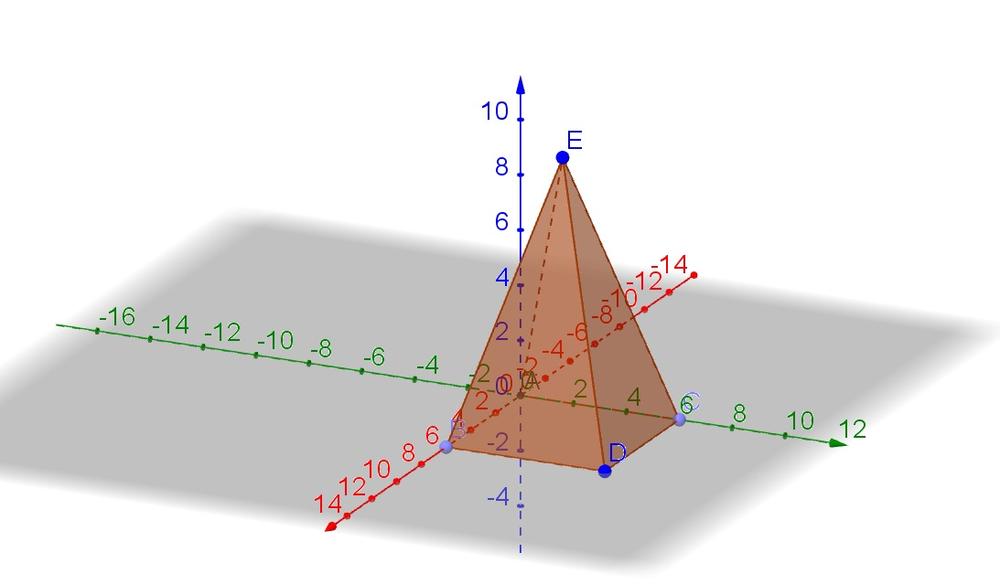
Volume 120 units
$$
V=dfrac{pi r^2 h}{3}=dfrac{pi 1.5^2 (6)}{3}=4.5pi
$$
Determine the volume of the cylinder with height $h$:
$$
V=pi r^2 h=pi 1.5^2h=2.25pi h
$$
The volumes should be equal:
$$
2.25pi h=4.5pi
$$
Divide both sides of the equation by $2.25pi$ :
$$
h=2 in
$$
$$
BD=sqrt{15^2-9^2}=sqrt{144}=12cm
$$
The radius is thus 6 cm and the area of the circle is then:
$$
A=pi r^2=pi 6^2=36pi approx 113cm^2
$$
$$
angle B=dfrac{1}{2}(30text{textdegree})=15text{textdegree}
$$
The sum of all angles in a triangle is 180$text{textdegree}$:
$$
mangle BDE=180text{textdegree}-15text{textdegree}-90text{textdegree}=75text{textdegree}
$$
The measure of the arc is twice the inscribed angle on the arc:
$$
moverarc{EB}=150text{textdegree}
$$
The tangent ratio is the opposite side divided by the adjacent rectangular side:
$$
AD=20tan{15text{textdegree}}approx 5.36cm
$$
$$
angle EDB=dfrac{1}{2}(86text{textdegree})=43text{textdegree}
$$
The sine ratio is the opposite side divided by the hypotenuse:
$$
EB=14sin{43text{textdegree}}approx 9.55
$$
b. $moverarc{EB}=150text{textdegree}$, $AD=5.36$ cm
c. 9.55 cm
When there are two intersecting chords inside a circle, as shown in the figure:
[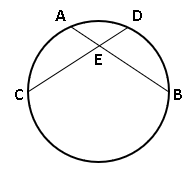](https://postimg.cc/QVJQR05H)
The measures of the segment of each chord can be described by the equation:
$$begin{gather}
AE cdot EB = CE cdot ED
end{gather}$$
We are given with the figure:
[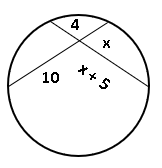](https://postimg.cc/752fyZcm)
Determine the value of $x$
Using the concept for two intersecting chords, we obtain the relationship between the segments using Eq (1) as follows:
$$begin{aligned}
AE cdot EB &= CE cdot ED \
4 cdot (x+5) &= 10 cdot x \
4x + 20 &= 10x
end{aligned}$$
$$begin{aligned}
4x + 20 &= 10x \
20 &= 10x – 4x \
20 &= 6x \
x &= frac{20}{6} \
&= boxed{3.33}
end{aligned}$$
The value of $x$ in the circle with two intersecting chords is $3.33$
$$
(x-1)^2+(-3x+5)^2=4
$$
Rewrite:
$$
x^2-2x+1+9x^2-30x+25=4
$$
Subtract 4 from both sides of the equation:
$$
10x^2-32x+22=0
$$
Factorize:
$$
2(x-1)(5x-11)=0
$$
Zero product property:
$$
x-1=0text{ or }5x-11=0
$$
Solve each equation to $x$:
$$
x=1text{ or }5x=11
$$
$$
x=1text{ or }x=dfrac{11}{5}
$$
Next, determine the corresponding $y$-value to each $x$-value:
$$
begin{align*}
y&=-3x+5=-3(1)+5=
\ y&=-3x+5=-3cdot frac{11}{5}+5=-frac{33}{5}+frac{25}{5}=-frac{8}{5}
end{align*}
$$
Thus the graphs intersect at $(1,2)$ and $left(frac{11}{5}, -frac{8}{5}right)$.
$$
0=x^2-3x-10
$$
Factorize:
$$
(x-5)(x+2)=0
$$
Zero product property:
$$
x-5=0text{ or }x+2=0
$$
Solve each equation to $x$:
$$
x=5text{ or }x=-2
$$
Since we also have the equation $y=2$, the graphs intersect at $(5,2)$ and $(-2,2)$.
b. $(5,2)$ and $(-2,2)$
$$
dfrac{8}{6}=dfrac{4}{3}
$$
b. The area is the product of the area of the similar figure and the ratio squared:
$$
A=27cdot left( dfrac{4}{3}right)^2=27cdot dfrac{16}{9}=48units^2
$$
c. The volume is the product of the volume of the similar figure and the ratio cubed:
$$
V=135cdot left( dfrac{4}{3}right)^3=135cdot dfrac{64}{27}=320units^3
$$
b. 48 units$^2$
c. 320 units$^3$
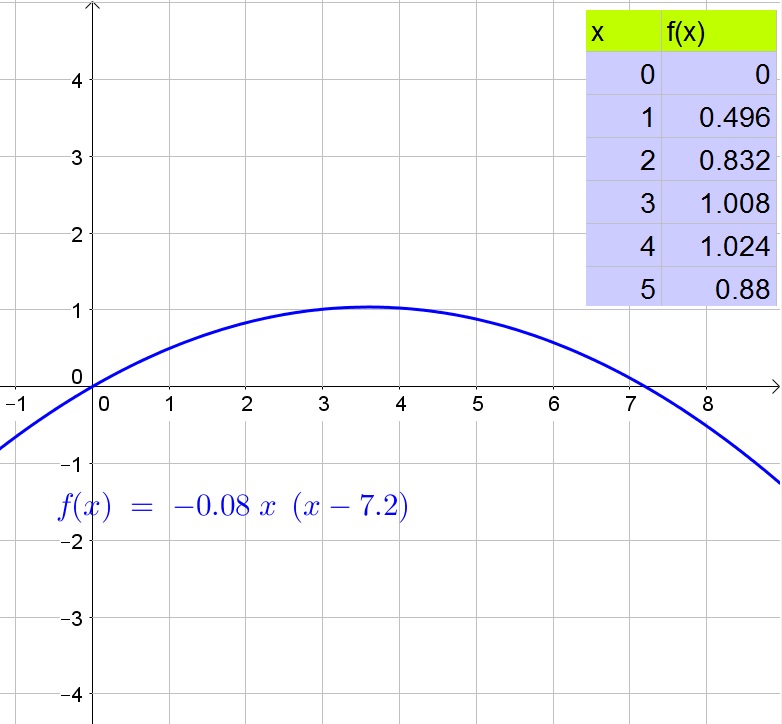
c. The $x$-intercepts are $x=0$ and $x=7.2$, while the $y$-intercepts is $y=0$. The vertex is $(3.6, f(3.6))=(3.6,1.0368)$.
$x$-intercepts: 0 and 7.2
$y$-intercept: $y=0$
Vertex $(3.6, 1.0368)$
$$
x=-dfrac{b}{2a}=-dfrac{-2}{2(1)}=1
$$
Its image is then:
$$
f(1)=1^2-2(1)-8=1-2-8=-9
$$
The vertex is then $(1,-9)$ and since $a=1>0$ the vertex is then the minimum. The range is then also $[-9,+infty)$.
Determine the $x$-intercepts:
$$
0=x^2-2x-8
$$
Factorize:
$$
0=(x-4)(x+2)
$$
Zero product property:
$$
x-4=0text{ or }x+2=0
$$
Solve each equation to $x$:
$$
x=4text{ or }x=-2
$$
thus the $x$-intercepts are $x=4$ and $x=-2$.
Finally the $y$-intercept is $y=-8$.
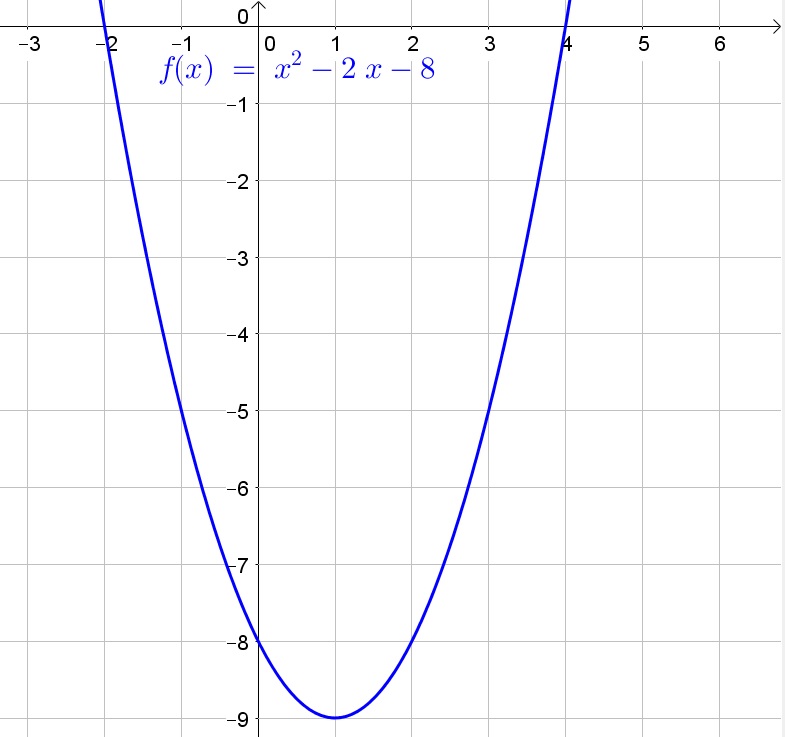
Range: $[9,+infty)$
$x$-intercepts: $-2$ and 4
$y$-intercepts: $-8$
Vertex $(1,-9)$

